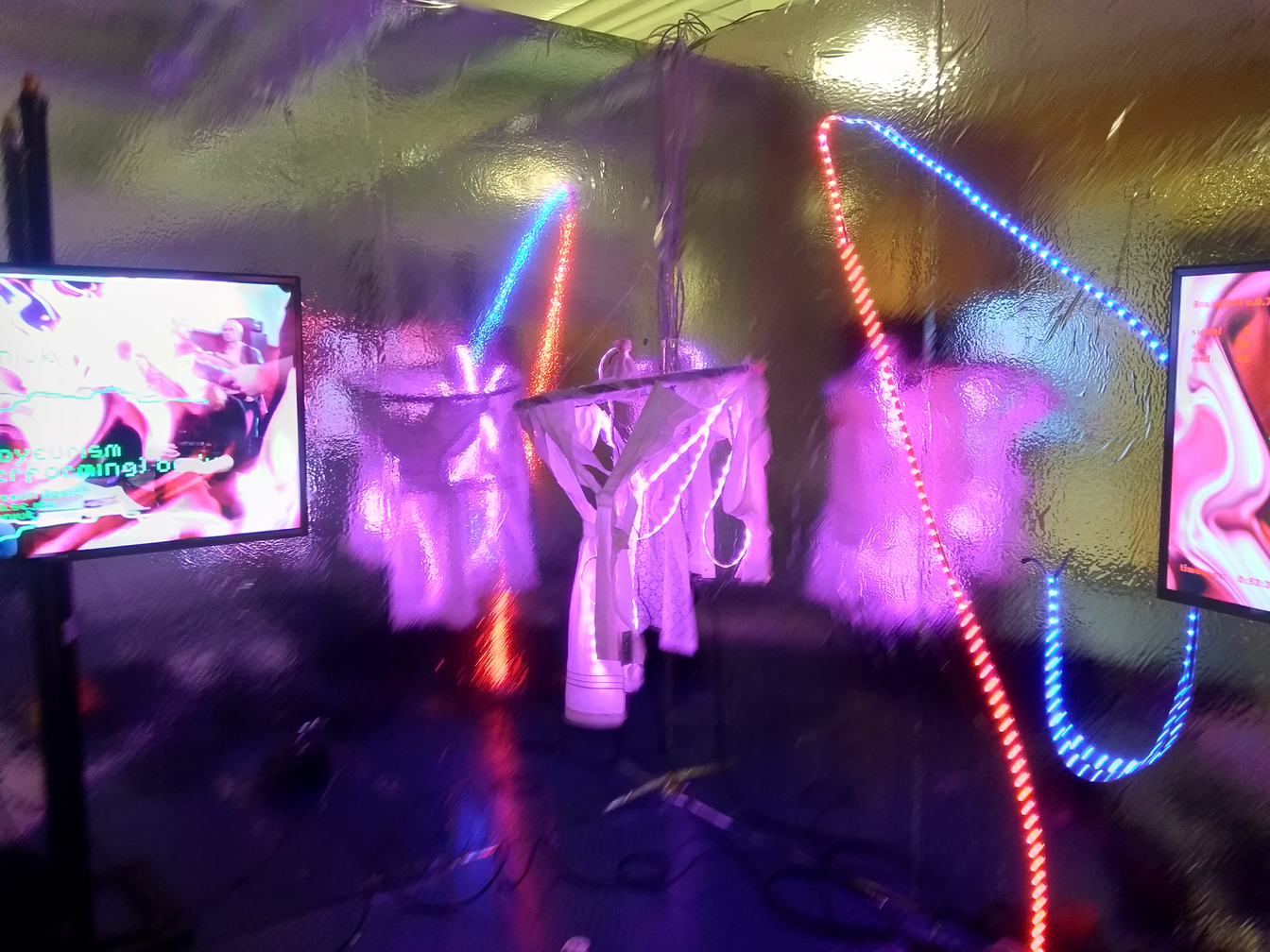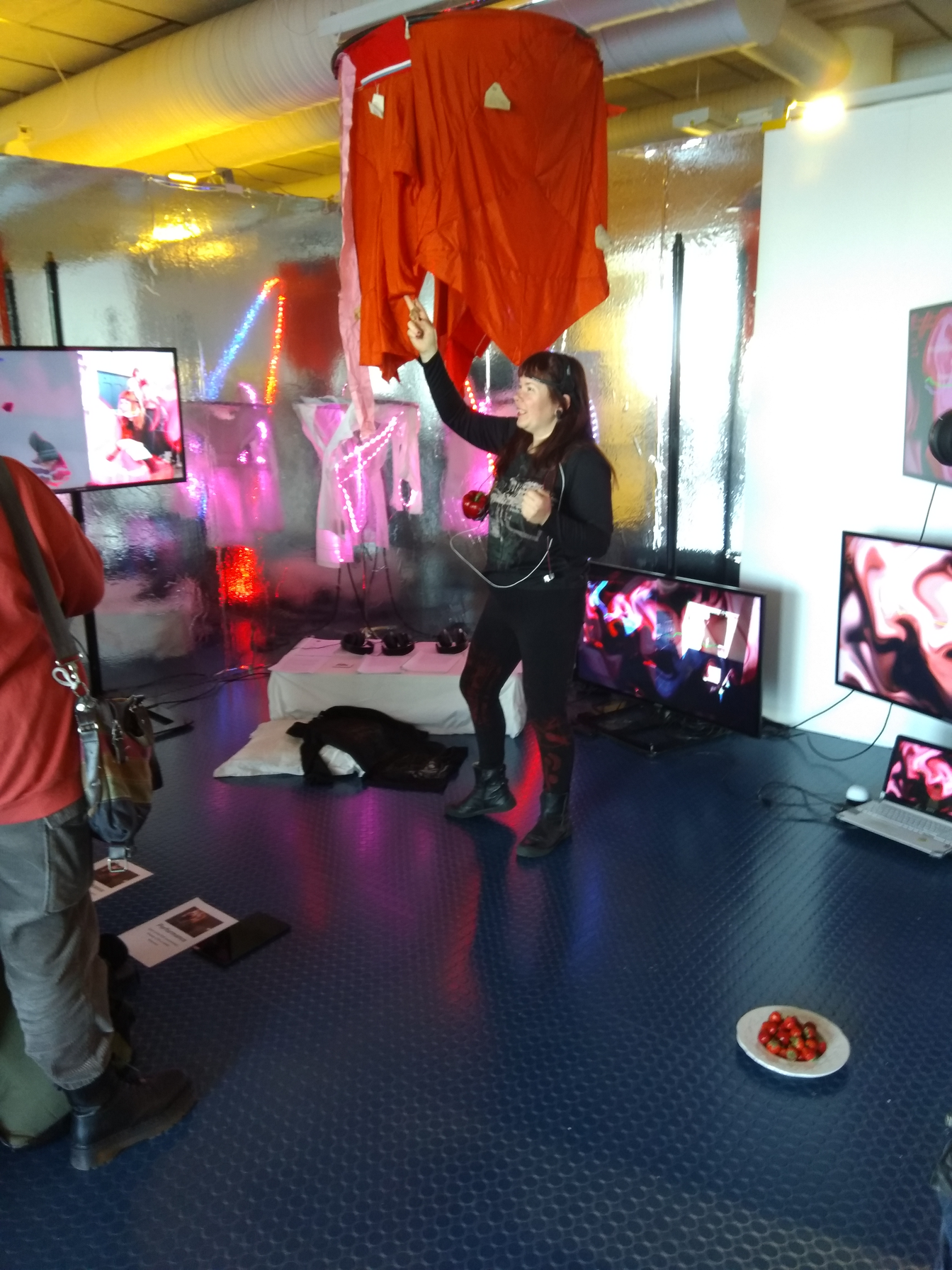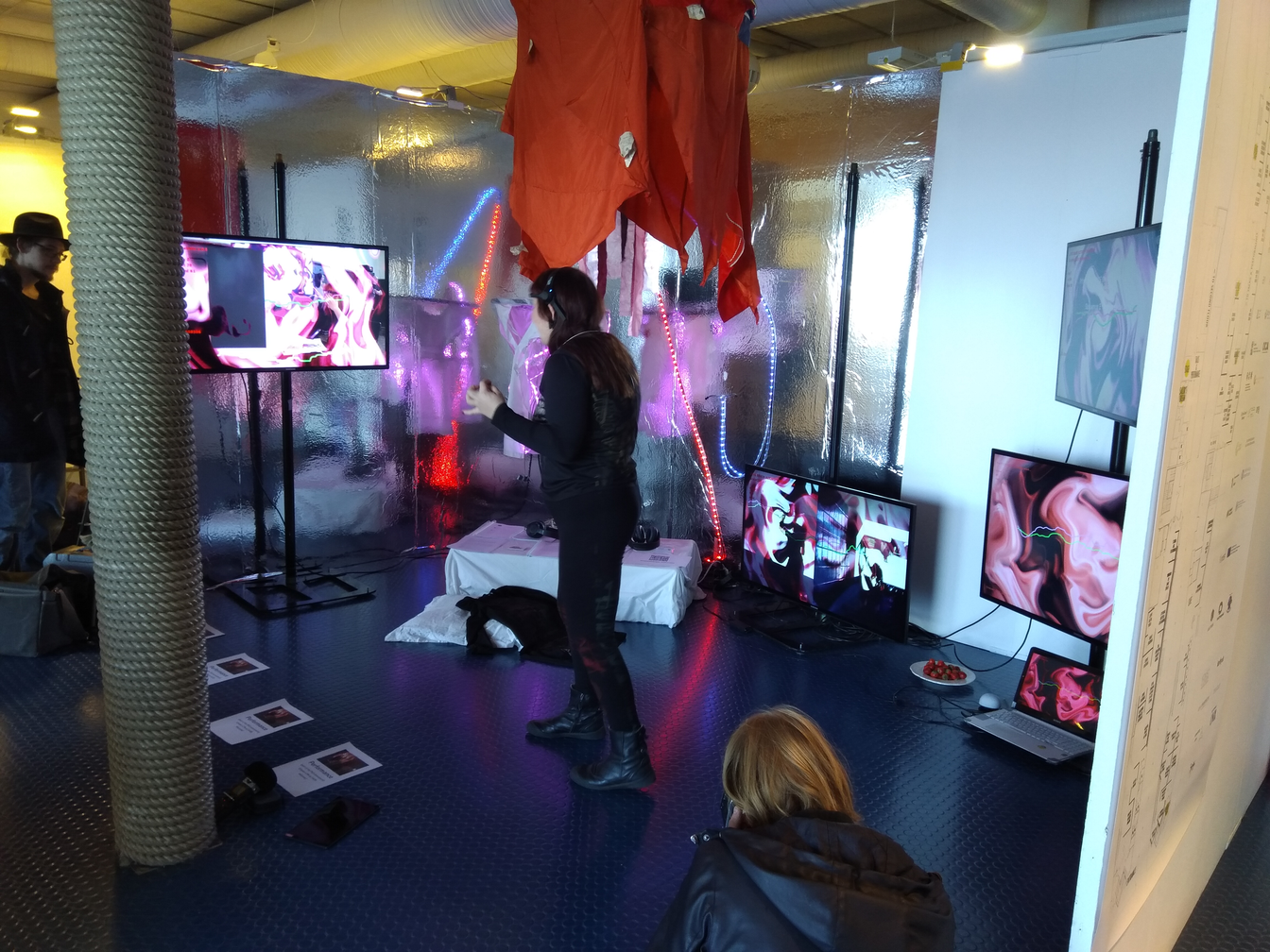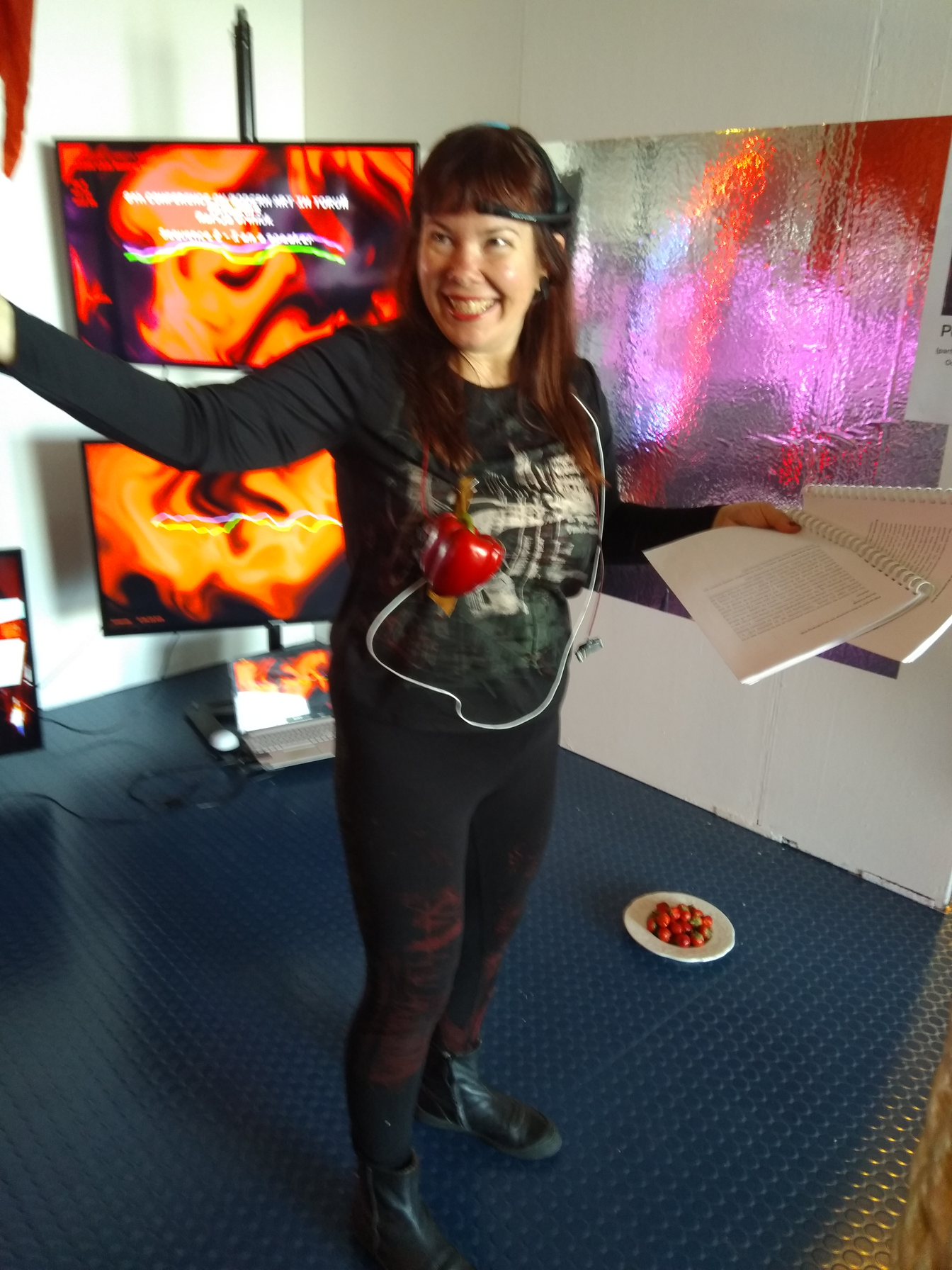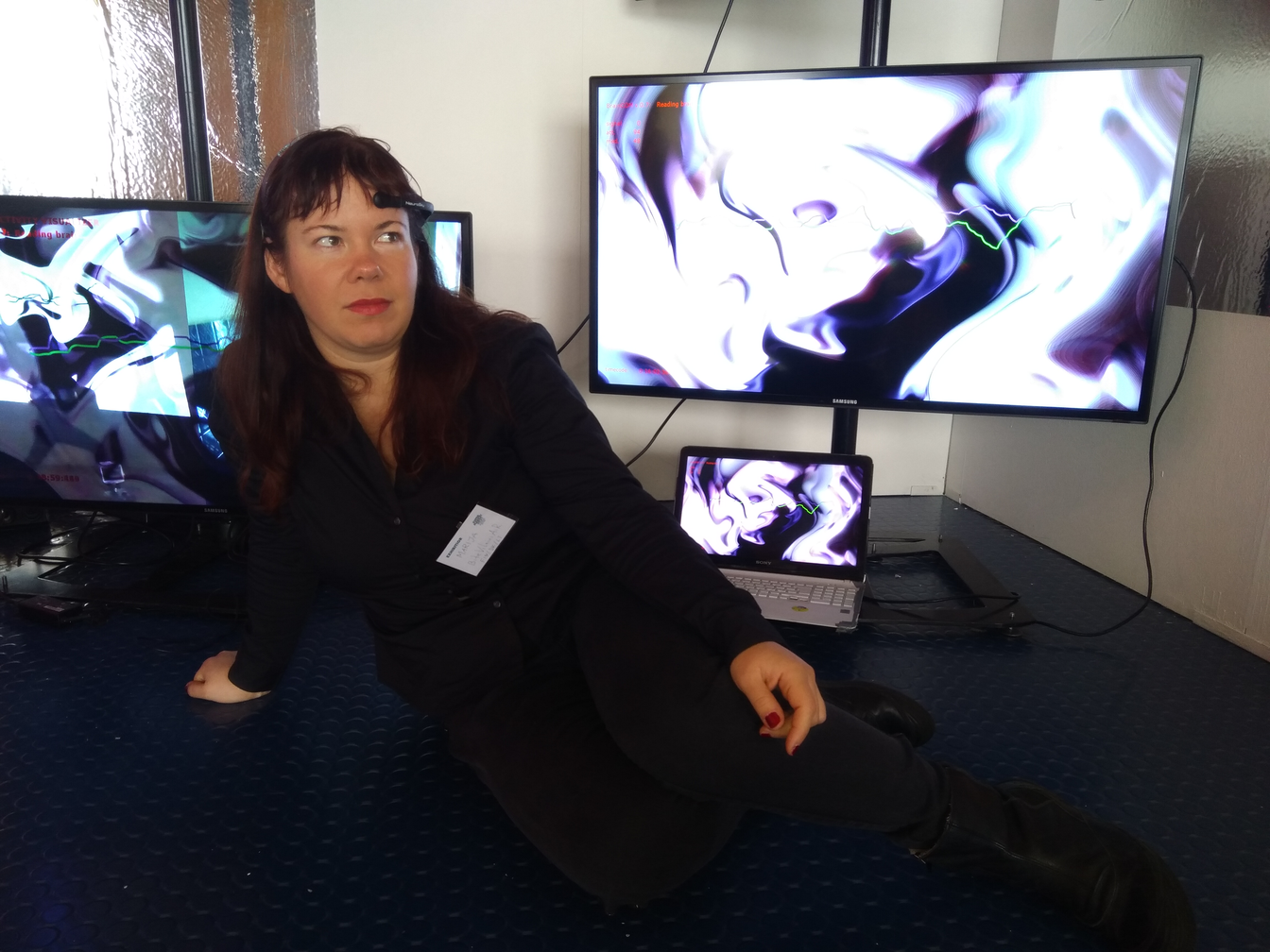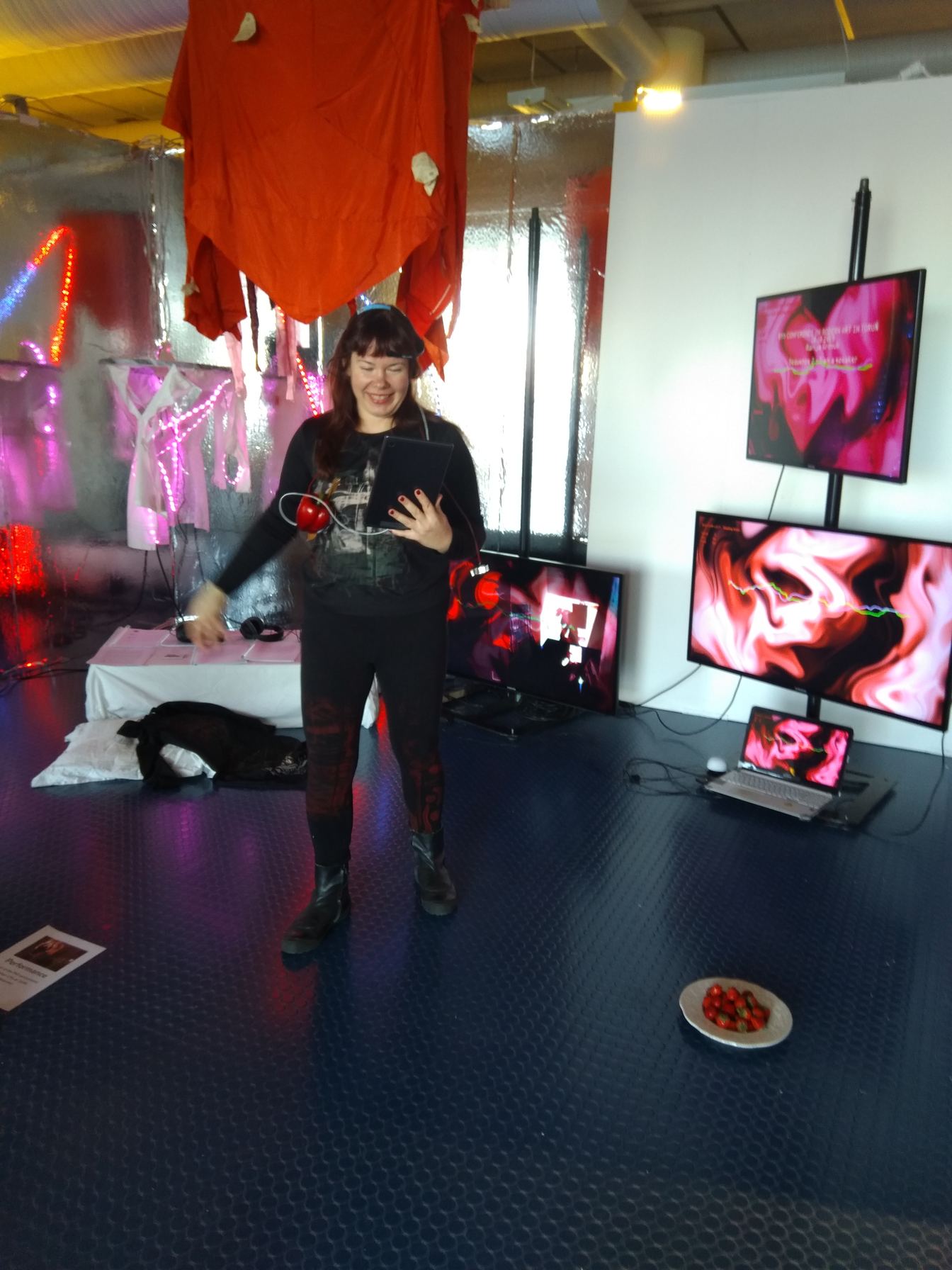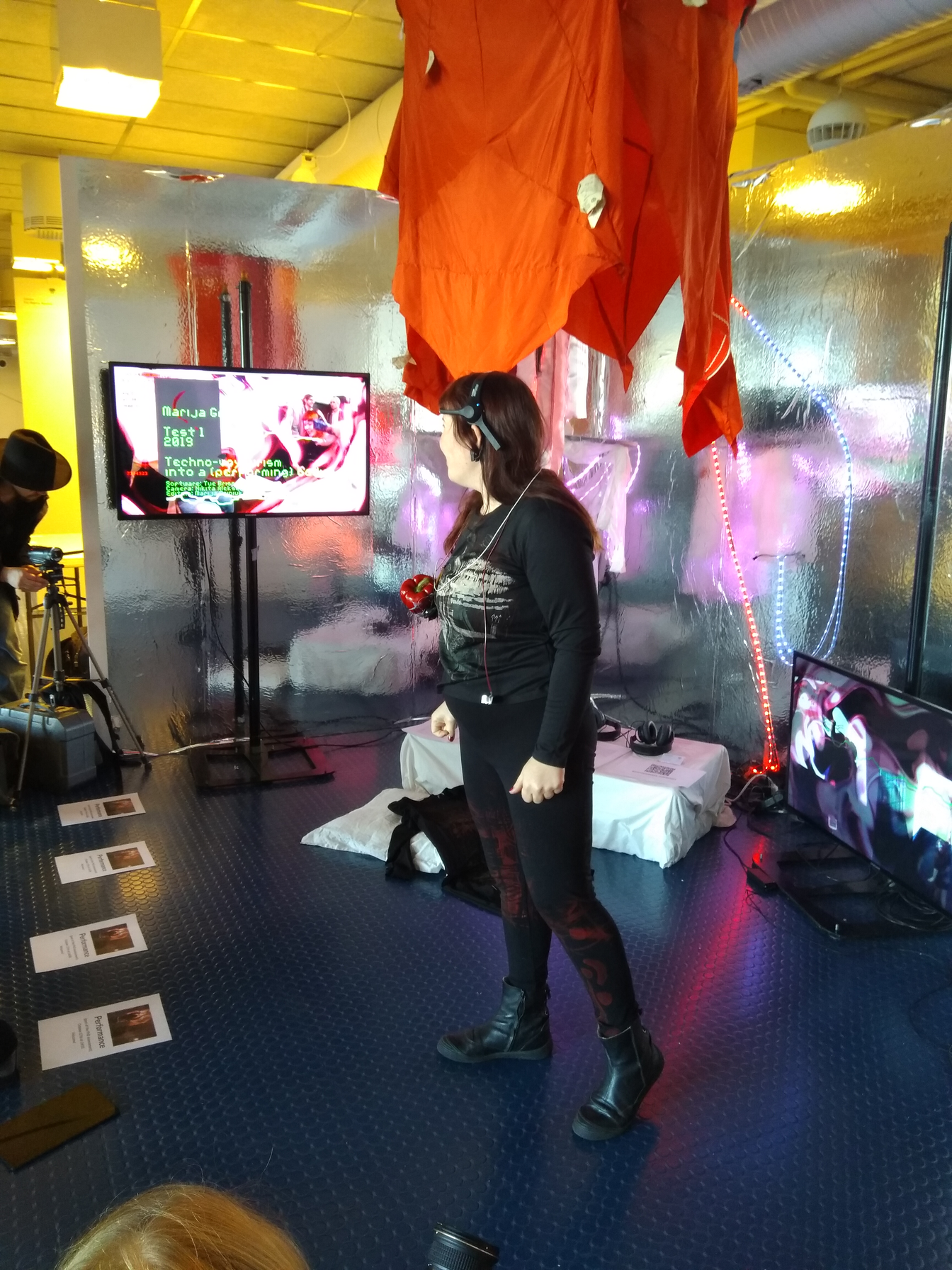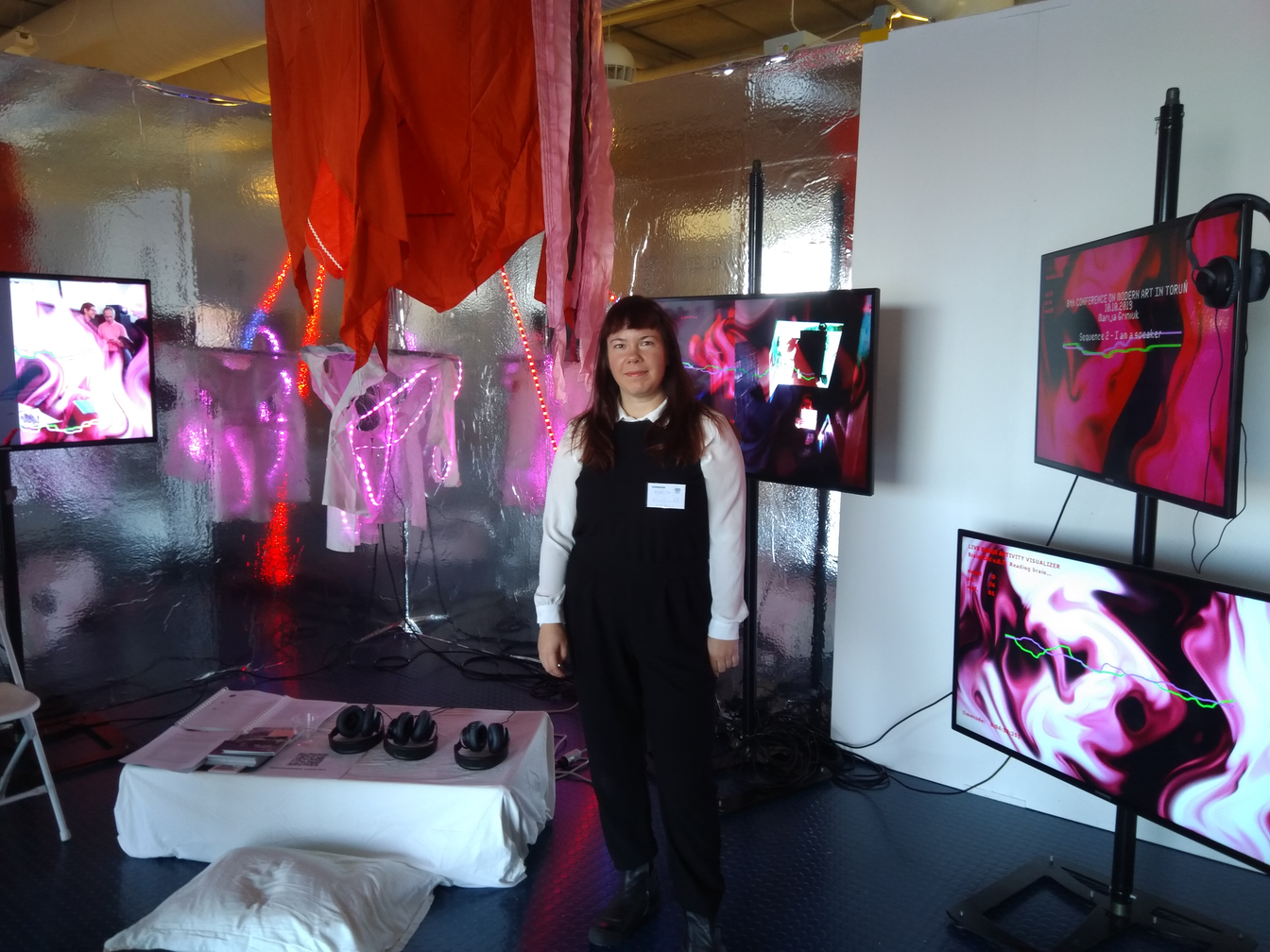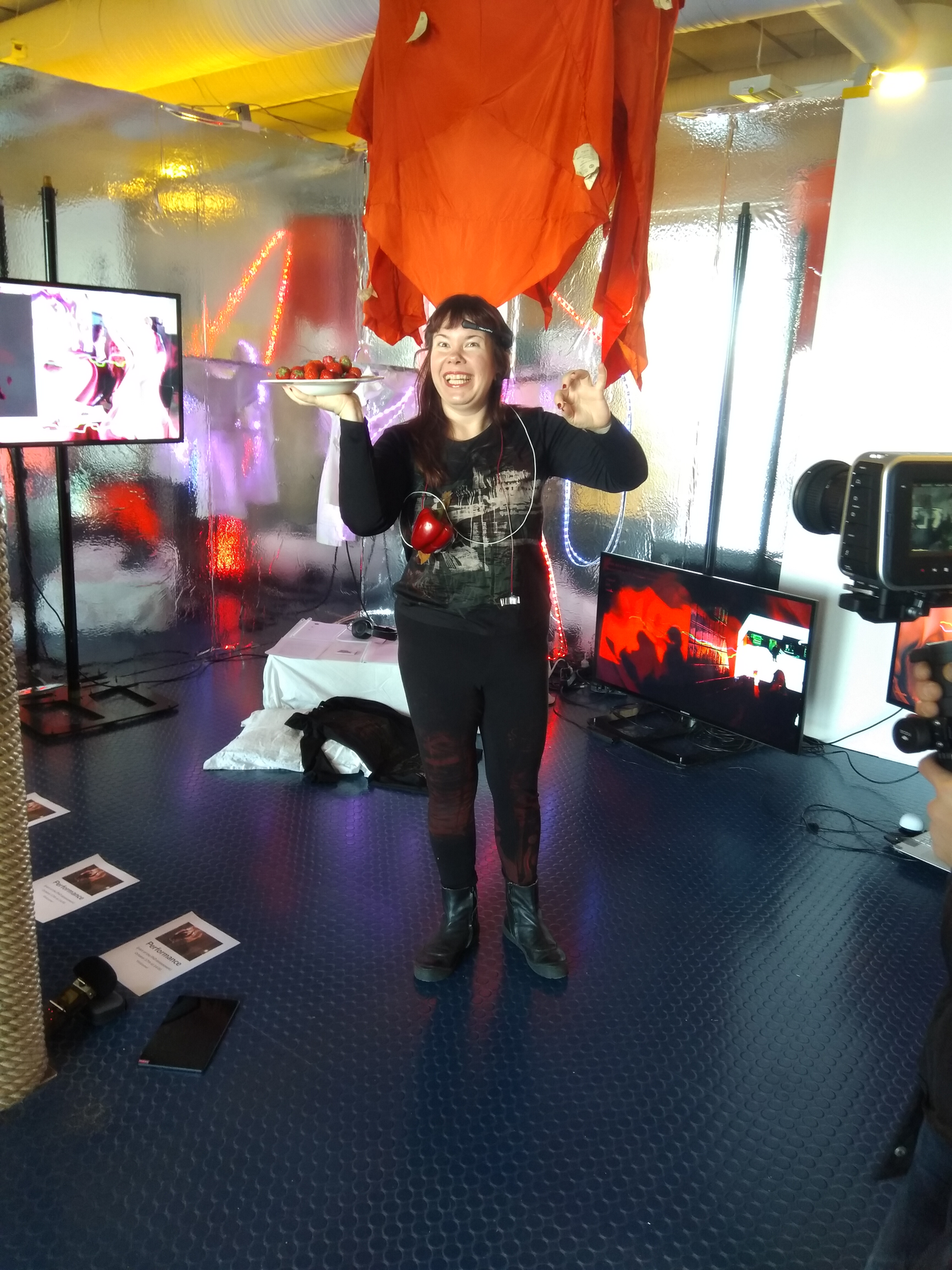Layering and Multileveledness in Performance Artwork Containing Documentation of Past Performances
Marija Griniuk
1 Introduction
The study explores the performance artwork, containing documentation from the previous performances, contributing to creation of the new artwork, and the perception of such performance artwork by the audience. Documentation of the previous performances as the part of the current artwork here is explained as layered by the artist and perceived by the viewers through the framework of multileveledness. The traditional methods of performance documentation, such as documentation by videos, photos or sound recordings or text is extended to documentation by the biometric data, in particular EEG (electroencephalography), from the performing body, which has been the core of the PhD research by the author during the last three years.
The objectives are following: to situate the main keywords by the literature sources in the context of the current discussion; to present and analyse the case-performance; to extract the key points of how such layering impacts the interaction of the artist with the audience members, while they perceive the artwork, which simultaneously can be interpreted as documentation of the past performances and the new artwork in its holistic approach. The research question in this exposition is: How layering impacts multileveledness of perception of the performance artwork, containing documentation from previous performances? The aim of the research is to analyse the case and to extract the main key points of the impact of layering on interaction and empathic connections-building with the audience members. The study unfolds the observational notes from the perspective of the artist along with the process notes, sound, video and photo documentation of the case-performance and the components of the installation as the site of the case-performance. The study presents the two-angled take on the case performance, where on the one hand is discussed layering within the performance documentation, while on the other multileveledness of perception by the audience members, where the researcher looks into the key meeting points between the concepts of layering and multileveledness, which make an impact on how the audience interacts with the performance documentation. -->
3 Method
Arts-based research deals with a “cluster of purposes” within investigation of art-making processes (Greenwood, 2019), as in the current case the performance containing documentation of the past performance artworks. Here the art-making, in particular including earlier documentations in the current performance, is discussed in the context of innovation/developmental purpose of an innovation. The data collection was conducted as the systematic reflective and observational notes during the four days of the durational performance “Techno-diving into the liveness of the unbodied performed body of memory” at Supermarket Art Fair 2021. The research was focused at development of innovative take on documentation within performance making. In arts-based research the projects “engage with aesthetic understandings as well as with discursive explanations” (Greenwood, 2019) where at the core is coming to know through art, as the process. Arts-based research steps into the university education context introducing art as the tool into the traditional ways of conducting the research. Arts-based research contains objectives within artwork creation (Greenwood, 2019), as in the current case. If the artwork does not contain an objective, it's an artwork, but not a research. In arts-based research the connectedness between the purpose and selected art tools is identified (Greenwood, 2019), as in the current research performance serves the purpose of a test-environments to find out how layering can be interrelated to multileveledness.
The arts-based research (Leavy, 2018) analyses the data produced during the artistic process, or as the consequence of the artistic process, as in the current performance the data - the notes - were taken as the consequence of performative interactions with the viewers. As explained by Leavy (2018) the source of the research data - the performance - is highlighted as one case/source for qualitative data collection and analysis. Further the case-performance served as the site for reporting the previous findings of the earlier conducted pilot-performances. As Greenwood (2019) explains the presentation of findings “The presentation is not only the reporting of findings: it is also art”. Simultaneously with the case-performence being the space forreporting the previous findings, it is the research project where the new data is gathered, as the performer interacts with the participants and takes notes about the process of interaction. Further, the case-performance is filmed and photographed. The collected data is analysed using general inductive analysis, where the key themes are extracted from the qualitative text- and image-based data, containing photos and videos (Thomas, 2006). -->
Marija Griniuk. Dau two of the event.Techno-diving into the liveness of the unbodied performed body of memory at Supermarket Art Fair, 2021. Photo: Tue Brisson Mosich. -->
5 Findings
Within the findings the keyword layering will be unfolded from these perspectives: cyclic aspect of layering; interconnectedness and gap between the physical body and the documented body, which can be narrowed down by the involvement of biometric data as one of the layers in documentation; multilevelendess of access to the content, which allow the viewers to grasp the performance documentation from their preferred scope of interactions with it.
a) Cyclic aspect of layering
The process of layering is cyclic, as in the case-performance “Techno-diving into the liveness of the unbodied performed body of memory” the live performance simultaneously becomes the new layer of documentation of the performative action which happened for the viewer right now. The screen which was connected to performer’s live brain activity was the part of the installation, so the performer was the integrated part of it, as the living being on the site of performance, producing the active component of the installation. Together with this, the production happened while the performer performed. The cyclic aspect of this layering is the active component of the narrative within the performance, as this EEG data which is produced and becomes the active part of installation now, in the next artwork will become the part of the documentation of the past performance.
b) Lessening the gap between the physical body and the documented body
The three layers of documentation are proposed: the physical, the mental and the social (Gorichanaz , 2017), which originates from the context of more traditional, object-based art. For example in the media of painting, where painting is interpreted as documentation (containing painter as persona, process of painting and socio economic aspect of this production), which in a way comes close to the discussion about the documentation of performance, as all these aspects are contained performance as well: performing persona, the process of performing and circumstances of performing. Thus if in the traditional documentation by image the contrast between the physical body and the documented body is present, the layer of documentation by biometric data from the body allows the processual look at the inner conditions of the body while one performs. The layered documentation, proposed in this research, containing the video image of the performance, as an action and site and the remediated records of the inner states of the performing body enables the closer connection between the physical body and the documented body for the viewer, as besides the image of performance, there is a layer of the representation of inner conditions of the body. The traditional documentation in the format of video and sound further helps the artist and the audience to trace, along with the documentation by EEG, when the moments of cognitive load, excitement or relaxation occurred during the performances.
Marija Griniuk. Techno-diving into the liveness of the unbodied performed body of memory at Supermarket Art Fair, 2021. The installation. Photo: Tue Brisson Mosich. -->
Vignette, day 1 of performance:
Interestingly, if people stay to interact, they do it quite durationally, or the one interaction turns into a 30 mins conversation, with the unfamiliar person. I don't quite know how much of the information I can say to people when they enter the booth. I try to start slightly and then go in depth depending on how long people are staying, and even go into the stories, personal stories of uniforms or images, saying for example that the person in the photo is my grandfather, whom I never met. -->
Note: Explore the exposition by dragging, using the Contents menu, or the small arrows -->
Marija Griniuk.Techno-voyeurism into a (performing) body. Performed at The Biennial "Art Future/Future Signs" in Riga, Latvia, 2019. Video: Nikita Aleksejev. Editing: Marija Griniuk
Vignette, day 3 of performance:
The interaction lasted around 15 mins, I started to talk about performance from Riga. Somehow when I talked the screen got blinking, where my live brain activity was shown, so I said about it, that I am concentrated as I talk, but I was calm in the conference setting in Torun. As I said that I showed the screen with the records of conference presentation from Torun, then I invited him to listen to sounds and said that the sound is the same as in the screen in the Parnu performance and then I asked if he prefers the sound or visual peace of documentation from the performance in Parnu, then I talked about the uniforms, and asked what he thinks it is, he said that he thinks it is produced for the cosiness of the place, I said yes, it looks really cosy. I said I had the white aprons at school when I was little and I asked what he thinks are those red objects, I said they were for covering the neck when wearing the uniforms, he said that looks more sporty, I asked- something like in the summer camp for the kids? He said yes. Then he moved on….
Sometimes people walk while talking on the phone. They talk on the phone and look. -->
c) Multileveledness of perception
Multileveledness of perception of the performance builds on giving the audience access to the physical aspect, as the artefact of the performance in the form of audiovisual production, where the technology is explained and the elements of the installation are introduced within the performed narrative; and the mental and social aspects, both connected to the records of the inner states of the performer, bound to the physical location of the performance, the narration within performance and the audience. Therefore here unfolds another aspect of layering as the layers of communication within the performance. As it was exemplified in the vignettes the duration of interaction is directly interconnected with the entrance through these layers: some of the audience members encounters the installation containing artistic persona/the performer; other members of the audience encounter persona and the technical aspect of the artwork and media; other members of the audience encounter artistic persona, media, information within the artwork and socio-cultural placement of the artwork. All these ways of interaction, designed within the artwork, are aimed at providing the possibility for multivelevedness of interaction and perception of the artwork by the audience members. -->
Marija Griniuk. Day four of the event. Techno-diving into the liveness of the unbodied performed body of memory at Supermarket Art Fair, 2021. The performer is including the sculptural object, sown of the school uniforms from 1970s-1990s into the narrative of her performance. Photo: Tue Brisson Mosich. -->
4 Case-performance at Supermarket Art Fair 2021
The performance “Techno-diving into the liveness of the unbodied performed body of memory” at Supermarket Art Fair 2021 happened in the booth of BiteVilnius AiR, the artist-run platform initiated and realised by the author, as the all day during the open hours performance, containing some breaks. The artwork was presented as the ongoing performative intervention within the installation in the booth, which revealed the multisensory perspective on remediated EEG (electroencephalogram) and the impact of it on performative communication and immersive storytelling via the performed memory, containing the performers story and the archive of the photo images from the auto ethnographic perspective of the artist. The performance was aimed at investigating how the improvisational tools within the vocal storytelling, the multichannel experience, containing sounds and images, along with the performer, moving in between the objects of installation can impact the interconnectedness of the performer with the audience.
The installation of “Techno-diving into the liveness of the unbodied performed body of memory” contained the following elements: the TV screens showing the sequences of the past performance, containing the images of the set up of performance and the performative action and visualisation and sound of the remediated EEG data. The walls of the booth were covered with the mirror foil, except the few spots on the wall where the intervention of white colour was aesthetically needed. The LED-lights in two stripes were mounted in the following way: one on the wall and the other inside the sculptural textile object. These stripes were intended to communicate by colours the conditions of relaxation and concentration within the past two performances. Besides the installation in the booth and performance within the installation, there was the paper with QR code on the wall, which contained the downloadable link to all the peer-reviewed articles within the research of the author. All the articles were themed around the new ways to document performance via EEG data from the performing body. The content of the installation was presented as follows -->
2 Documentation and layering of participatory performances
The key themes within this research are documentation, layering, multileveledness and participatory performance. Documentation within the case-study is integrated part of the participatory performance artwork, thus the spectators are seeing and interacting with the live performer within the installation, containing documentation of the past performances. The connection between documentation and performance is within the processual approach to both. The previous research suggests to see documentation in the processual aspect (Gorichanaz, 2017). Documentation comes from the definition of document as evidence in support of a fact that, and how, under what circumstances, an artwork was realised/created (Gorichanaz, 2017). Gorichanaz (2017) suggests interpreting an artwork as a document. According to Auslander theatrical and documentary documentation, both serve as the factual evidence of the past performance, although produced as different processes (2006). Building upon the definition by Auslander, Gorichanaz (2017) introduces the neo-documentation perspective (present in the discourse from the mid-1990s) of the document as semiotic, where the symbolic means of the content of the document is bound to the circumstances of process of documentation, while the document remains the factual representation of e.g. performance. Documentation included in the case-performances is directly attached to the moment it’s production - the layer of biometric data is including the processual aspect - how the body cognitively reacts to the variety of moments within performance. The participatory aspect of performance, containing live performer within the documentation arranged as the installation set-up, is important due to the aspect of audience involvement that develops empathic connections, which within participatory performance are two-sided: with both participants and the spectating audiences, in this way performance communicates towards two directions at the same time (Bishop, 2011). The case-performance realysed in the context of an art fair in the non-traditional set up, excluding the notion of the stage and the viewers. Such type of performance is explained by Schechner's (1977) definition that performance is a wide spectrum of restored behaviour activities containing facilitator/the performer, participants, audience, space and time of performance. The transformation within performance (Schechner, 1977) is the key aspect for the performance to happen and thus the artwork to develop and be completed over the duration of the performative intervention. This transformation addresses the key themes: layering and multileveledness, as transformation in this approach can be interpreted as multilevel.
Vignette, day 2 of performance:
There are periodic interactions, where the situation is alike, people stop from time to time and stay longer or shorter…To most visitors I would tell the technical things first and then go into the conceptual details of postcolonial history, which is the content of my performative narration. It seems to me that my work has two levels, first when I talk about brain activity, and that image and sound is made of brain activity and if a person tries out the sounds or starts to read and stays, then the second layer comes as a the story about the uniforms and the photos and then something else. -->
Marija Griniuk. Techno-diving into the liveness of the unbodied performed body of memory at Supermarket Art Fair, 2021. The performer is using her family photoarchive on the tablet to include into the narrative the themes of post-colonial memory and eco-violence in Lithuania. Photo: Tue Brisson Mosich. -->
6 Conclusion
The research investigated by means of arts-based research the performance art case, containing the installation, built of the past performances, the documentations of those performances by image, sound and biometric data from the performing body and the live narrative-based performance within the installation. The key points, as layering and miltileveledness were introduced from the aspect of cyclic approach to documentation, lessening the gap between the performing and documented body and allowing the audience the wide range of the ways how to interact with and interpret performance. The additional layer of documentation, which is remediated biometric data, besides video and sound records of performance, deepens for the viewer the experience of the body behind the image of performance. In this way layering within the documentation, initiated by the artist contributes to the concept of multileveledness of perception by the viewer. The research clarifies the aims with involvement of biometric data into the performance documentation. This paper is the part or the larger-scale PhD research-investigation into the new methods to document performance art by the newest consumer-available EEG technology, recording the conditions of cognitive concentration and relaxation of the performer.
The performative actions were aimed at connecting to the audience members within the venue of the art fair, which has the very specific tradition for spectatorship, where the viewer goes from work to work and encounters thus the large amount of the audiovisual information. The interactions with the audience members ranged widely: from a glance and smile while the viewer passes by talking on a phone; photographing the QR of the articles and moving on; to the durational conversations of approximately thirty minutes. The following vignettes show the immediate observational reflections from the performing artist as the interactions unfolded over the duration of the performance.
The sculptural textile objects from the installation were sown from the school uniforms from the times of the Soviet occupation in Lithuania and Ukraine, the uniforms themselves originated from the Ukrainian manufacturing from 1970s-1990s and were exactly of the same style that were worn by my generation of schoolchildren in the first decade of independence in Ukraine. The only difference was that in the soviet times the red scarf was worn and after 1991 it disappeared as the uniform element. In the sculptures I used the red scarfs for one object and the white aprons for the other object. Interestingly, from all audience members only one group of three visitors recognised that one of the objects contained the scarfs from the school uniforms from the Soviet time.
The description of the installation and the vignettes from the wide range of interactions within the durational performance provide the holistic overview of layering of documentation, which becomes the new artwork on the site of the booth at Supermarket Art Fair. The findings within investigating the interconnectedness of the two aspects - layering and multileveledness of perception - are unfolded in findings. -->
Marija Griniuk. Techno-diving into the liveness of the unbodied performed body of memory at Supermarket Art Fair, 2021. The performer is explaining the meaning of the graphical stripes in the screen, conected to live EEG data. Photo: Tue Brisson Mosich. -->
Marija Griniuk, in collaboration with Kaspar Aus. The Monument to the Present Moment. Performed at Parnu Art Week in Estonia, 2021. Video: Tue Brisson Mosich. Editing: Marija Griniuk
Layering in the case-performance builds upon the definition of layering as combining multiple elements with the purpose of stimulating creativity of the viewer (Cupchik & Gignac, 2007). Layering is closely linked to the notion of enhancing emotional and empathic connectedness between the artist and the viewer (Cupchik & Gignac, 2007), which is at a core in performance artwork. Though by Cupchik & Gignac, (2007) layering is discussed in connection mainly to the static images, such as paintings or printmaking, in this study layering is adapted to performance art and connected to the concept of documentation. Here the layers aimed at enhancing empathic connectedness contain the actual physical body within performance, the image of the performance perceived as documentation, the narrative of the past performances becoming the new artwork, all creating one aesthetic experience for the viewer and unveiling the spectrum of possibilities of interaction within the site of installation and performance within it. Multiveleledness as a “capacity of a work of art to be grasped, elaborated and experienced in several systems of connected potential meaning” (Kraitler & Kreitler, 1972, p. 294) is the response to layering from the side of the audiences. In the performance artwork multileveledness suggeststhe multiple way the spectator can perform their interaction with the performer. Specifically in the case-performance the layered documentation of past performances became the new artwork, simultaneously adding the new layer to the case-installation, containing past performances, due to the fact that current (at the time of performing) performance becomes the past performance immediately after its realisation. Multiveleledness allowed more than one level of interpretation, which could be understood as multiplicity of paraphrasing what the artwork can be about. This leads to the greater range of interactions, allowing depth of emotional response from the viewer (Bornstein, 1973), which in the interpretation within performance art impacts the closer empathic connection between the artists and audiences. -->
Marija Griniuk. The fourth day of the event. Techno-diving into the liveness of the unbodied performed body of memory at Supermarket Art Fair, 2021. The performer is explaining the element of the installation - the performance, conducted in Riga in 2019. Photo: Tue Brisson Mosich. -->
References
Auslander, P. (2006). The Performativity of Performance Documentation. PAJ: A Journal Of Performance And Art, 28(3), 1-10. https://doi.org/10.1162/pajj.2006.28.3.1
Bishop, C. (2012). Artificial hells: Participatory art and the politics of spectatorship. Verso Books.
Bornstein, M. (1973). [Review of Psychology of the Arts, by H. Kreitler & S. Kreitler]. The Journal of Aesthetics and Art Criticism, 32(1), 123–127. https://doi.org/10.2307/428719
Cupchik, G. C., & Gignac, A. (2007). Layering in Art and in Aesthetic Experience. Visual Arts Research, 33(1), 56–71. http://www.jstor.org/stable/20715434
Ellis, C. & Bochner, A. P., (2000), Autoethnography, personal narrative, and personal reflexivity, In N. Denzin & Y. Lincoln (Eds.), Handbook of qualitative research (2nd ed., pp. 733-768). Thousand Oak, CA: Sage Publication.
Greenwood, J. (2019). Arts-Based Research. Oxford Research Encyclopedia of Education. https://doi.org/10.1093/acrefore/9780190264093.013.29
Gorichanaz, T. (2017).Understanding Art-Making as Documentation
Kreitler, H. & Kreitler, S. (1972). The psychology of the arts. Durham, NC: Duke University
Press.
Leavy, P. (2018). Introduction to arts‑based research. In P. Leavy (Ed.), Handbook of arts-based research (p. 3–21). Guilford Press.
Schechner, R. (1977). Essays on Performance Theory, 1970–1976. Drama Book Specialists.
Thomas, D. R. (2006). A general inductive approach for analyzing qualitative evaluation
data. American journal of evaluation, 27(2), 237–246.
Vignette, day 4 of performance:
The man with the camera looked at the TV screen with the image from the performance from Parnu and I told what was on the screen. Then he asked if he could take a photo. I said yes. But he did not photograph. I pointed at the realtime screen, it was red while I explained the symbolics of colours. I asked if he could like the documentations of the performances in the museums or similar places. He said that often the performance documentations are annoying. I asked why. He said that often they are noisy and giving discomfort. But he says that other times they are cosy, when there is a place to sit down. He said that here the sound is pleasant.
Some people do not come close, but look from some metres away. I try to interpret it as if they do not want to talk with me, then I just sensually feel they are there and they look, or even take a photo, but I would not talk.
The person is reading the abstract, looking at the things and I think I will let the person finish reading. I started to speak after a few minutes, we sat down on the floor and it was I think really performative, some people would stand and see and listen. He asked how it is possible to do research through art, and I said that it is possible and that then the research become like cycles of art and publishing. He sat for some 30 minutes and I felt very happy about that.
Marija Griniuk. Day 4 of the performance.Techno-diving into the liveness of the unbodied performed body of memory at Supermarket Art Fair, 2021. The performer is sharing printed-out copies of her peer-reviewed articles, where the involved into the installation performance documentations were the case-performances. Photo: Tue Brisson Mosich. -->
Marija Griniuk. Day 2 of the performance.Techno-diving into the liveness of the unbodied performed body of memory at Supermarket Art Fair, 2021. The performer is inbetween the direct interactions with the audience members. Photo: Tue Brisson Mosich. -->
Marija Griniuk. The fourth day of the event. Techno-diving into the liveness of the unbodied performed body of memory at Supermarket Art Fair, 2021. The performer is using her family photoarchive as the active part of the narrative within performance. She shows photoarchive from the tablet device in her hands . Photo: Tue Brisson Mosich. -->
Marija Griniuk. Day four ofthe performance.Techno-diving into the liveness of the unbodied performed body of memory at Supermarket Art Fair, 2021. The performer is explaining the content of the performance conducted in Riga in 2019. Photo: Tue Brisson Mosich. -->
Marija Griniuk. The first day of the event. Techno-diving into the liveness of the unbodied performed body of memory at Supermarket Art Fair, 2021. The photo was taken for the communication reasons and was included in communication of the artwork in the social media. Photo: Tue Brisson Mosich. -->
Marija Griniuk. The fourth day of the event. Techno-diving into the liveness of the unbodied performed body of memory at Supermarket Art Fair, 2021. The performer is sharing the berries with the audience memebers, which are tha active part of the narrative connected to the photoarchive, used in the performance. Photo: Tue Brisson Mosich. -->
Marija Griniuk. Techno-diving into the liveness of the unbodied performed body of memory at Supermarket Art Fair, 2021. The performer is introducing the sounds in the installation (the same sounds as presented in this exposition). Photo: Tue Brisson Mosich. -->

